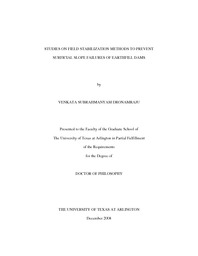
ATTENTION: The works hosted here are being migrated to a new repository that will consolidate resources, improve discoverability, and better show UTA's research impact on the global community. We will update authors as the migration progresses. Please see MavMatrix for more information.
Show simple item record
| dc.contributor.author | Dronamraju, Venkata S. | en_US |
| dc.date.accessioned | 2009-09-16T18:18:42Z | |
| dc.date.available | 2009-09-16T18:18:42Z | |
| dc.date.issued | 2009-09-16T18:18:42Z | |
| dc.date.submitted | January 2008 | en_US |
| dc.identifier.other | DISS-10030 | en_US |
| dc.identifier.uri | http://hdl.handle.net/10106/1702 | |
| dc.description.abstract | Surficial failures are occurring frequently on the slopes of earthfill dams which are predominantly rainfall induced. Desiccation cracks form on the slope surface during dry environment which accelerates infiltration during rainfall. Infiltration causes increase of pore water pressures and saturation of soil mass in top layer resulting in surficial failures. Numerous surficial failures occurred on the slope of earthfill dams maintained by The United States Army Corps. of Engineers. The current research is undertaken at the University of Texas at Arlington with an objective of exploring the best field stabilization method to mitigate these surficial failures.Two sites, Joe Pool Dam and Grapevine Dam located in Fort Worth district were selected for the research. The admixtures used to treat the embankment soil were 20% compost, 4% lime with 0.30% polypropylene fibers, 8% lime with 0.15% polypropylene fibers, and 8% lime. These stabilizers were proven to be promising from a laboratory study in mitigating desiccation cracking. Five test sections including four treated sections and one control section were constructed at each dam site. The test sections were instrumented with moisture probes, temperature probes and inclinometers. The moisture content and temperature was recorded for a period of one year at Joe Pool Dam and the data was analyzed using statistical comparison tools. Besides, the vertical movements of the test sections were monitored by conducting elevation surveys and the lateral movements were monitored by conducting periodical inclinometer surveys. Digital image studies were conducted to monitor the desiccation cracking observed in the test sections. Physical model studies were also carried out to study the relative performance of soil treated with admixtures when it was subjected to a number of alternate wetting and drying cycles. Additional laboratory tests were conducted and the data was used to carry out numerical modeling studies using PLAXFLOW and GSTABL7 software programs. Based on the analysis of the data, the image studies, and the analytical model studies, the 8% lime with 0.15% fibers is found to be the most effective admixture followed by the 8% lime to prevent desiccation cracking and surficial failures of high plasticity clays. | en_US |
| dc.description.sponsorship | Puppala, Anand | en_US |
| dc.language.iso | EN | en_US |
| dc.publisher | Civil & Environmental Engineering | en_US |
| dc.title | Studies On Field Stabilization Methods To Prevent Surficial Slope Failures Of Earth Fill Dams | en_US |
| dc.type | Ph.D. | en_US |
| dc.contributor.committeeChair | Puppala, Anand | en_US |
| dc.degree.department | Civil & Environmental Engineering | en_US |
| dc.degree.discipline | Civil & Environmental Engineering | en_US |
| dc.degree.grantor | University of Texas at Arlington | en_US |
| dc.degree.level | doctoral | en_US |
| dc.degree.name | Ph.D. | en_US |
| dc.identifier.externalLink | http://www.uta.edu/ra/real/editprofile.php?onlyview=1&pid=969 | |
| dc.identifier.externalLinkDescription | Link to Research Profiles | |
Files in this item
- Name:
- DRONAMRAJU_uta_2502D_10030.pdf
- Size:
- 15.10Mb
- Format:
- PDF
This item appears in the following Collection(s)
Show simple item record


